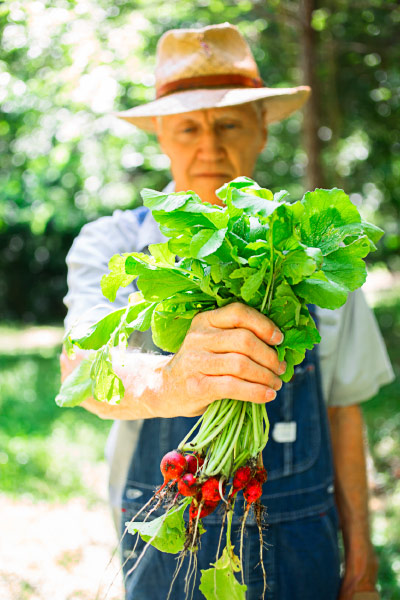Ecologically-Based Growers Face Obstacles and Market Could Help
 |
|
What are the challenges for a farmer with radishes? |
Money, as they say, makes the world go round. So too money has spun the world of food, particularly food produced using IPM and organic practices. For decades, corporations have responded to consumer preference for food that is produced and sold inexpensively. With the rise in rapid communications like social media and the Internet, and an increasingly educated and concerned public, consumers have begun voicing their concerns in the food marketplace. Consumers are choosing organic, healthy, and less-processed food. Along with the rise of health food stores is demand for sustainable production practices, which are being scrutinized more closely by food suppliers and distributors of all scales.
What will happen to conventional farming practices in the coming years? Will the market lead to reduced use of pesticides? Or will pesticide resistance—and toxicity in humans and the environment—lead to more regulation? Will IPM and organic fill the gap? A combination of these scenarios could happen. If so, significantly more research dollars will be needed to uncover ecologically-based answers to the problems, which have been given a temporary fix for far too long.
At present, adherents of the organic movement create market demand for products, practices, and their related ecosystem services. Still, more could be done. IPM is a part of organic just as it is a part of conventional agriculture. Will environmental issues like we have never had before force change to happen? The timing may be right for IPM to shift conventional growers toward more ecologically-based practices, which would have the greatest impact on all practices, including organic.
Challenges
People in the public sector are discussing a number of agriculture-related issues with regard to food safety, production practices, and human health. The National Water Quality Inventory Report to Congress indicates agriculture continues to be the US’s leading source of surface-water pollutants. Poor pesticide-use practices have led to more than 1,000 species of insects, mites, plant diseases and weeds developing resistance to pesticides worldwide, generating more than US$1.5 billion in costs per year (Pimentel 2005). Crop losses include damage by resistant pests, costs of additional pesticide applications required to control resistant pests, and costs associated with bringing new pesticides to market to replace those no longer effective due to resistance. Current estimates are that 237 weed species have developed resistance to 155 different herbicides (Heap 2014) in 66 crops in 61 countries worldwide. Farm workers have elevated risks of brain, cervix, prostate, stomach, lymphatic and bone cancers. Calvert et al. (2008) reported 3,271 acute pesticide-related illnesses among farm workers between 1998 and 2005. A growing body of literature on occupational exposure to pesticides makes it a high priority across the globe.
A Model: Organics in the Market
Money that finally flowed into organic programs, like the National Organic Program (NOP), Organic Materials Review Institute (OMRI), and USDA helped fuel the emerging movement and fledgling industry that supported it. Now, organic is seeing exponential growth in production and product sales, with demand continuing to exceed supply for many products.
The same cannot be said for marketing “IPM-grown,” which is hindered by low consumer awareness and appreciation. With federal regulation of the organic label, and the marketing and education campaigns that accompanied it, came a surge in demand for organic products in the marketplace, along with greater legitimacy for organic methods within the agricultural research and Extension establishment. Global sales of organic in 2012 were approximately US$63.8 billion. Despite all the growth, organic remains a tiny fraction of world and US agricultural production. The US has a total of 844 million acres (342 million Ha) of land in agricultural production, with 0.6% of it organic. Depending on your viewpoint, the glass is either half full or half empty.
What’s in a Name?
One challenge with IPM is in the name; integrated pest management. As much as people do not like pests, they loathe even more a pest label put on their food. In the 1990s, the New York State IPM Program and a large grocery store chain attempted an IPM labeling program. Support for the program was pulled in 1999, as there were several issues associated such as lack of recognition of IPM by consumers, a third category on already crowded shelves, stereotype associated with pesticides, and association of the word “pest” with the purchase of food.
A viable solution, for IPM, would be to follow industry in creating a new name. Crop consultants now specialize in resistance management and stewardship, which are synonymous with IPM in addressing pesticide resistant weeds, insects, and diseases. A similar approach could be used for labeling IPM food, such as integrated crop management (ICM) or sustainable agricultural solutions (SAS). Some groups, such as the not-for-profit food organization Red Tomato, the USDA’s Sustainable Agriculture Research and Education (SARE), and the Natural Resources Conservation Service (NRCS) are already moving in this direction. Will IPM adherents lag behind, or lead the way to a sustainable future?
This article is based on work of the North Central IPM Center’s Organic and IPM Working Group.
— by CHRIS GONZALES and STEVE YOUNG
The Northeastern IPM Center promotes integrated pest management for reducing risks to human health and the environment. If republishing our news, please acknowledge the source (“From Northeast IPM Insights”) along with a link to our website.
